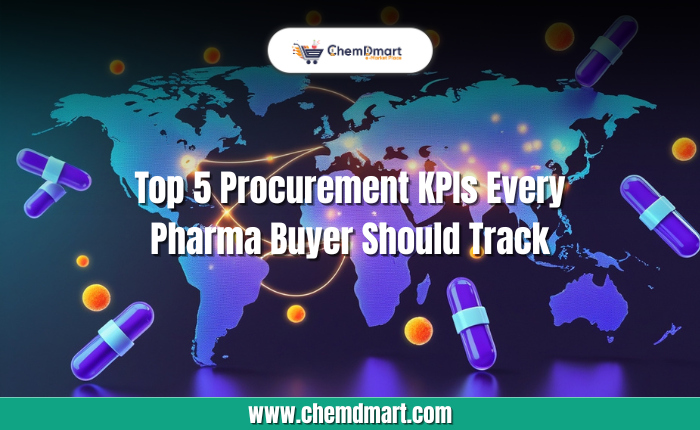
In pharma, one delay can mess up an entire drug launch. A shipment comes late, a supplier misses paperwork, and suddenly months of planning are gone. That’s why procurement teams can’t just buy and hope for the best anymore. You need warning signs before things break—and that’s where KPIs come in.
Today, pharma sourcing happens on global platforms and digital marketplaces. The old way of picking suppliers on price or trust doesn’t cut it. Buyers need hard data—numbers that show if a supplier is reliable, compliant, and worth the risk.
In this post, we’ll break down five must-track procurement KPIs that every pharma buyer should know. And we’ll show how ChemDmart makes it easy to see these metrics in real-time—so you don’t get blindsided when it matters most.
Tracking KPIs in pharma procurement isn’t optional—it’s a must. Without metrics, buying becomes reactive, leading to cost overruns, delays, and quality risks. Strategic sourcing, in contrast, anticipates demand, evaluates suppliers proactively, and ensures regulatory compliance.
Organizations that monitor procurement KPIs are 33% more likely to reduce supply chain disruptions and improve cost efficiency (Procurify). Metrics shift procurement from a simple cost-cutting role to a performance-focused function.
KPIs highlight bottlenecks and risks in the supply chain. By continuously tracking performance, procurement teams can plan dual/multi-sourcing strategies, avoid shortages, and maintain regulatory readiness.
|
KPI |
Why? |
|
Supplier lead time |
Delays ripple into production cycles |
|
Compliance rate |
Measures how many suppliers meet GMP, COA, DMF, GDP |
|
On-Time delivery % |
Reliability of shipment affects manufacturing |
|
Total cost of ownership (TCO) |
Sees beyond unit price- freight, rework, quality, delays |
|
Supplier Risk Score |
Combines financial, audit, geography risks into one metic |
Supplier lead time measures the total time from placing an order to receiving materials. Long or unpredictable lead times can disrupt production schedules, force last-minute sourcing, and increase costs. By tracking lead times across suppliers, procurement teams can plan buffer stocks, avoid delays, and negotiate realistic delivery expectations.
ChemDmart provides historical delivery data for each supplier, helping buyers choose partners that consistently meet deadlines.
Compliance rate indicates the percentage of suppliers who meet required standards such as GMP, COA, DMF, and GDP. A low compliance rate increases regulatory risk and potential inspection failures.
High compliance ensures that raw materials, APIs, and excipients are safe, traceable, and legally approved for use.
ChemDmart centralizes all validated compliance documents, allowing buyers to quickly assess a supplier’s readiness and reduce manual verification work.
This KPI tracks how often suppliers deliver orders on schedule. Late deliveries can stall production lines, cause missed milestones, and increase expedited shipping costs.
Monitoring on-time delivery helps procurement teams identify reliable suppliers and anticipate delays.
TCO looks beyond the purchase price to include shipping, quality issues, rework, storage, and delay costs. A supplier offering the lowest price may not provide the lowest total cost.
By analyzing TCO, procurement teams can make cost-effective decisions that account for real-world impacts.
The supplier risk score combines multiple factors—financial stability, audit history, geographic exposure, and operational risks—into a single metric. This KPI helps identify suppliers that could disrupt supply chains due to insolvency, non-compliance, or geopolitical challenges.
At the end of the day, KPIs aren’t just fancy numbers. They’re what turn buying raw materials from “let’s hope this works out” into a smart, planned process. With the right KPIs, pharma procurement stops being reactive and starts being strategic.
ChemDmart makes this way easier. Instead of digging through spreadsheets or chasing suppliers for data, you get real numbers—delivery stats, compliance docs, risk scores—right inside the platform. That means faster decisions, fewer surprises, and a stronger supply chain.
So if you’re tired of guessing and want to actually track how your suppliers perform, try ChemDmart. It’s the smarter way to source APIs, raw materials, and chemicals, and to keep your KPIs under control.
